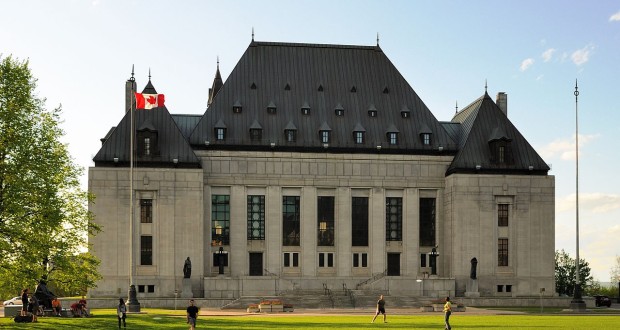I recently went on the Runnymede Radio podcast to discuss how the law on motions to strike pleadings to determine novel questions of law may be changing after decisions from the Supreme Court of Canada earlier this year in Nevsun Resources Ltd v Araya (“Nevsun”) and Atlantic Lottery Corp Inc v Babstock (“Atlantic Lottery”). In this blog post, I briefly summarize some comments I made in that podcast. I first describe what motions to strike are, then turn to their connection to the rule of law, and finally note how the law may be evolving in light of Nevsun and Atlantic Lottery.
Background
Motions to strike pleadings – or motions to determine questions of law (the two terms are not synonymous but have sufficient similarities in practice such that I will use the term “motion to strike” in this blog post to describe common usage) – are powerful but discrete tools in civil procedure. Among other things, they allow a court to conclusively determine that a cause of action (or defence) is (not) disclosed by a party’s pleadings. There is also, however, a high bar to use them. It must be “plain and obvious” that no cause of action is disclosed, however generously read. There are good reasons for this. No evidence is admissible on a motion to strike so one must assume that everything the plaintiff says is true and then, on her version of the facts, still come to the conclusion that she will inevitably lose.
As an example, the Ontario Court of Appeal’s 2015 decision in 1317424 Ontario Inc v Chrysler Canada Inc struck a nuisance claim where the plaintiff alleged that its ability to enjoy its property was impaired by a previous owner’s failure to remediate its land. The Court observed that it is an essential element of nuisance that whatever causes interference with land emanate not on the plaintiff’s land. As such, even if everything the plaintiff said was true, its nuisance claim could not succeed.
Access to Justice and the Rule of Law
Motions to strike can facilitate access to justice and the rule of law, two related concepts. On the access to justice front, they can facilitate resolving more cases more quickly with a determination of the case’s merits. If the plaintiff wins the motion to strike, it also makes more informed settlement likelier. The motions also unclutter the court system, allowing other parties to avail themselves of it. Using motions in this way accords with the spirit of the Supreme Court’s seminal 2014 decision in Hryniak v Mauldin (“Hryniak”), where Justice Karakatsanis emphasized that novel court procedures should be used to resolve more cases on their merits more quickly.
Motions to strike also uphold the rule of law for several reasons. One is by facilitating access to the courts. The Supreme Court discussed the connection between access to justice and the rule of law in the 2014 Trial Lawyers Association of British Columbia v British Columbia decision. More importantly, one of the requirements of the rule of law is that there be law and that it be reasonably clear. If the court can speak to what the law is on a motion to strike, that helps litigants and the entire legal profession, beyond the facts of the case in which there is a motion to strike. It also develops the common law which frequently is not otherwise developed as cases disappear into the ether and are settled, perhaps in an unprincipled way, in the face of legal uncertainty.
Where this is most controversial is when a party seeks to fundamentally change the law or have a new cause of action recognized. The courts have repeatedly held that novelty alone is not a reason to strike a claim. That is only logical, as the law is not static. But is novelty a reason not to strike a claim? That brings us to Nevsun and Atlantic Lottery.
Nevsun
Nevsun is sure to live in casebooks and textbooks for its determinations on questions of international law. The plaintiffs were allegedly conscripted into the Eritrean military, where they suffered grave violations of their human rights, including by being forced to work at a mine owned by a Canadian company. They later sued that Canadian company in British Columbia and the company brought a motion to strike for several reasons, two of which reached the Supreme Court.
The first reason related to the company’s allegation that the plaintiffs were actually seeking to have the Canadian court to determine the legality of Eritrea’s actions. And the company submitted that Canadian courts should be forbidden from doing so pursuant to the “act of state doctrine”. By a 7-2 margin, the Supreme Court rejected this argument, holding the act of state doctrine is not part of Canadian law. (In dissent, Justice Côté disagreed on the merits, but agreed that this could be resolved on a motion to strike.) This is commendable: whether the act of state doctrine is part of Canadian law is a question of law that can be determined without knowing the facts of what occurred at the mine. Now, all litigants and lawyers can order their affairs more predictably knowing that this is not part of Canadian law.
By a 5-4 margin, the Court did not strike the claims based on proposed new torts for violations of international human rights law. Justice Abella, writing for the majority, held that it was not “plain and obvious” that these claims would fail and it would be a question for the trial judge whether the torts exist and what form they should take.
Justices Brown and Rowe wrote for the dissent on this point, emphasizing that novelty should not be a bar to resolving a legal issue on a motion to strike. They cited scholarship by Stephen Pitel and Matthew Lerner to note that, if a court will not recognize a new cause of action on the most favourable facts possible – the facts in the pleadings – then the action is doomed to fail. They noted that the plaintiffs’ claims to have these new torts recognized were contingent on several theories, several of which were clearly doomed to fail. These included:
- the corporations must obey international law prohibitions;
- that it would make no sense for international law to impose criminal liability on corporations (which it does in certain situations), but not civil liability;
- the relevant international law is automatically adopted as part of Canadian law, which they viewed as based on a flawed understanding of how international law becomes part of Canadian law (which was also controversial in this month’s decision in Quebec (Attorney General) v 9147-0732 Québec inc); and
- there is no adequate domestic remedy.
Without addressing the merits of these propositions in too much detail, it would appear as though knowing the facts of the plaintiffs’ case – i.e., what happened at the mine – may be irrelevant to answering the legal questions. In particular, the company was either bound by the relevant international law or it was not. The facts of what happened to the plaintiffs are not helpful – and may even be distracting – in making that determination. Declining to use the motion to strike to determine whether the new torts existed – or, at least, the constitutive element of whether a corporation can be bound by international law in the absence of a treaty – therefore appears a missed opportunity to streamline litigation and develop the common law.
Atlantic Lottery
A few months later, Justice Brown found himself writing similar sentiments regarding motions to strike in the face of unsettled questions of law. But this time he was in the majority.
Atlantic Lottery’sunderlying facts could not have been more different than those in Nevsun. This was a proposed class action filed in Newfoundland. The defendant approved the operation of Video Lottery Terminals in Newfoundland & Labrador, and the class alleged that these were inherently dangerous and deceptive. Three primary causes of action were asserted:
- waiver of tort;
- breach of contract; and
- unjust enrichment.
For none of these causes of action did the class seek damages for losses incurred by the class members. Rather, they sought disgorgement of sums received by the defendant. And they primarily emphasized waiver of tort. This is a very old private law concept, whereby a plaintiff waives his or her tort remedies to receive disgorgement remedies that one might otherwise be entitled to in contract law, even when there is no contract. Historically, however, it still required the existence of a tort for tort remedies to be waived. So can it be a standalone cause of action? From a policy perspective, one could make a case that it should be, especially when defendants are profiting from breaching a standard of care.
Justice Brown, for a unanimous Supreme Court, disagreed. There were several reasons, notably the private law’s primary purpose of compensation, and what he feared would be an undesirable consequence of recognizing a cause of action that did not require damages. This could incentivize prospective plaintiffs to pursue lawsuits as quickly as possible and receive “windfall” judgments.
From a procedural perspective, what was more interesting is that he emphasized why this was such an appropriate claim to resolve on a motion to strike. He cited four reasons:
- The law of restitution had changed since previous decisions not to decide this issue.
- Hryniak held that courts must look to procedural mechanisms to prevent claims that are doomed to fail from surviving too long in the civil justice system: “It is beneficial, and indeed critical to the viability of civil justice and public access thereto that claims, including novel claims, which are doomed to fail be disposed of at an early stage in the proceedings. This is because such claims present ‘no legal justification for a protracted and expensive trial’.” [emphasis in original]
- To not decide the issue would perpetuate legal uncertainty. No Canadian court had recognized waiver of tort as a standalone cause of action. But several had held that it was not plain and obvious that it was not a standalone cause of action. Such perpetual uncertainty is undesirable.
- Unlike a previous case, where the court did not decide this issue, this was central to Atlantic Lottery.
These four reasons, taken together, may mean that Nevsun and Atlantic Lottery are distinguishable and the former’s reticence to use motions to strike is compatible with the latter’s bullishness. The first consideration will seldom be relevant in all future cases. But the second – the effects of Hryniak – will be, while concerns about perpetuating legal uncertainty and a legal question being central to a case will often be present in future cases.
Justice Brown went on to also strike the unjust enrichment and breach of contract claims. Regarding unjust enrichment, he held that, on the plaintiff’s own theory of the case, there was a juristic reason for the enrichment and as such the claim could not succeed. Turning to breach of contract, he interestingly agreed that there might be a claim for breach of contract. But it would yield expectation-based damages or nominal damages, while the class sought disgorgement damages and/or punitive damages, which were clearly not available on the pleadings. He thus held that there was no reasonable cause of action, again implying expanded availability of the motion to strike.
Justice Brown wrote for a unanimous court on the waiver of tort and unjust enrichment issues, but only five judges on the breach of contract issue, where he was joined by the three judges who joined him in Nevsun: Justices Moldaver, Côté, Rowe, but now also by Justice Abella. Justice Karakatsanis dissented only on the breach of contract claim. She observed – accurately – that loss is not an essential element of a breach of contract claim, and held that evidence was required before determining the inappropriateness of disgorgement or punitive damages. Justice Brown held that those remedies being appropriate would be inconsistent with the theory of the case in the pleadings.
The Upshot
It seems as though the Supreme Court may be liberalizing the ability to use motions to strike to resolve questions of law. At the same time, it is uncertain whether the principles in Atlantic Lottery are applicable more broadly. Even so, the decisions should generally be commended for moving in a direction to resolve more cases on their merits more quickly and develop the common law while doing so. I suspect we will be seeing more motions to strike to resolve novel questions of law in the future.
 Advocates for the Rule of Law
Advocates for the Rule of Law



